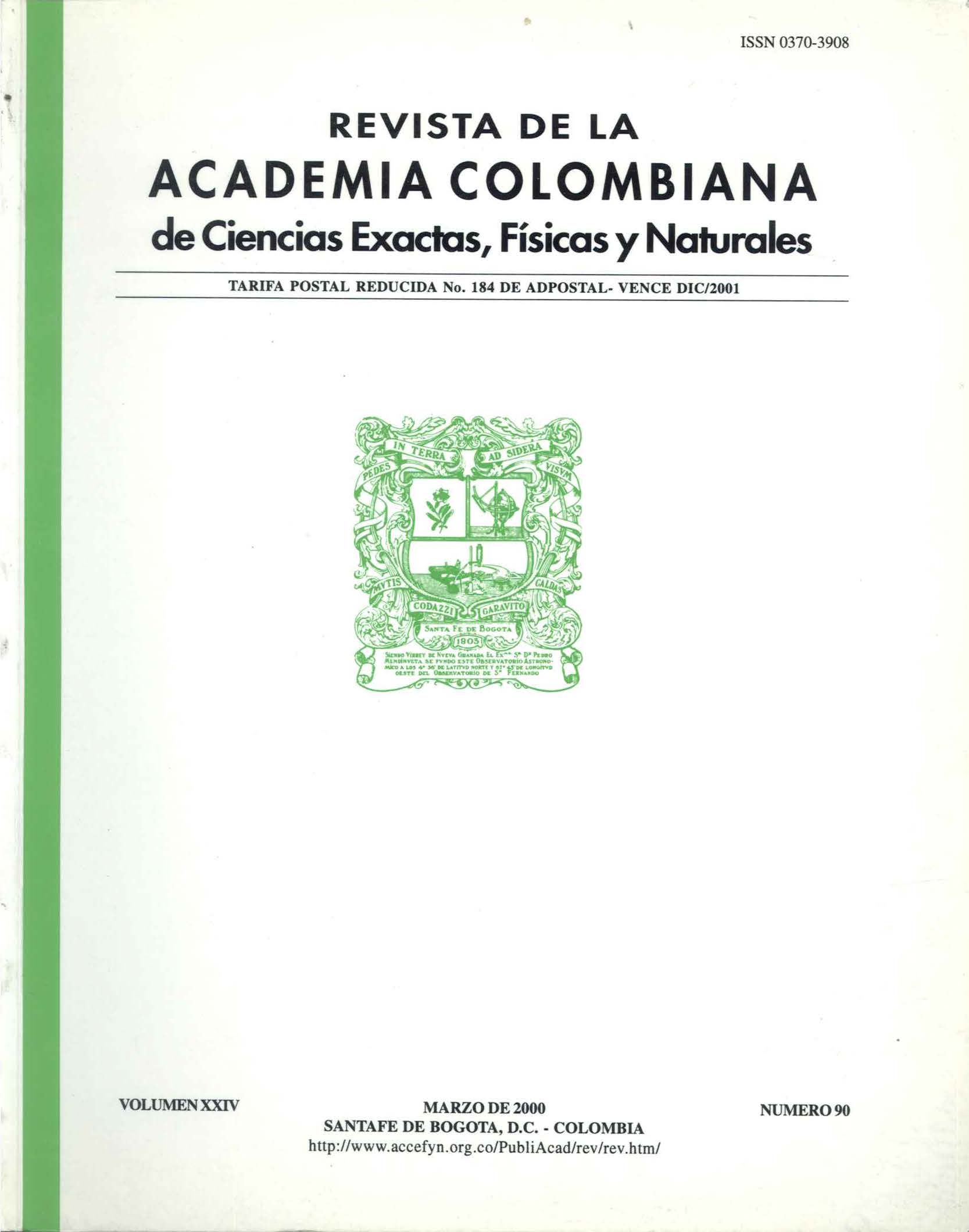Resumen
Se documenta la presencia de Orobanche minor Sm. en Colombia como planta naturalizada, lo que representa el primer registro para esta especie en la franja neotropical y la primera indicación de la familia Orobanchaceae en territorio colombiano. Se comentan algunos aspectos agronómicos de esta especie, que es reconocida en el mundo, como maleza frecuente en algunos tipos de cultivos y como planta nociva en predios ganaderos.
Referencias
Achey, D. M. 1933. A revision of the section Gymnocaulis of the genus Orobanche. Bull. Torrey Bot. Club. 60: 441-451.
Bermudez García, L. A. 1997. Malezas más comunes en Colombia. Produmedios. Bogotá. pp. 1-150.
Brako, L. & J. L. Zarucchi. 1993. Catálogo de las Angiospermas del Perú. Monograph. Sist. Bot. from Missouri Bot. Garden. 45.
Chater, A. D. & D. A. Webb. 1972. Orobanche. In: T. a·. Tutin & al. (eds.), FI. Europaea, vol. 3: 286-293. University. Press, Cambridge.
Cronquist, A. 1981. An integrated system of classification of flowering plants. Columbia university Press, New York.
Davies, W. E. 1959. Experiments on the control of broomrape in red clover. PI. Pathol. 8 (1): 19-22.
De Pamphilis, C. W. & W. D. Young. 1995. Evolution of parasitic Scrophulariac eae/ Orobanchaceae: Evidence from sequences of chloroplast protein gene rps2 and comparision with traditional classification schemes. Amer. J. Bot. 82 (6): Suppl. 126.
Fernández-Alonso, J. L. 1987. Scrophulariaceae. En: Flora de la Real Expedición Botánica del Nuevo Reyno de Granada. 39. Madrid.
Fernández-Alonso, J. L. 1996. Un gran grupo de familias: Las tubifloras (Subclase Asteridae), pp. 151-157. En: L. Montes & P. Eguiluz (eds.). El Cerro frontera abierta. Recorrido ecológico por el "Cerro de Usaquén". Ed. Santillana. Bogotá.
Frost, C. C. & L. J. Musselman. 1980. Clover broomrape in the United States. Weed Sci. 28: 119-122.
García-Torres, F. López-Granados, M. Castrejón-Muñoz, M. Jurado-Exposito, J. Díaz-Sánchez. 1998. Estado actual de las infestaciones de Orobanche spp. en Andalucía y perspectivas para su control. pp. 181-185. En: Gómez de Barreda & al. (eds.) Actas Congreso 1997, Sociedad Española de Malherbología. Valencia-España.
Gleason H. A. & A. Cronquist. 1998. Manual of vascular plants of Northeastern United States and adjacent Canada. 2•. ed. The New York Bot. Garden. Bronx. New York.
Halsted, B. D. 1898. Two Phanerogamous parasites of the Red Cover. Bull. Torrey Bot. Club 25: 395-397.
Haynes, R. E. 1970. Fam. 174. Orobanchaceae. pp. 131-134. En: R. E. Woodson & R. W. Schery (eds.). Flora of Panama.
Hipkin, C. R. 1992. Host range specificity of Orobanche minar Sm. on Crymlyn Burrows. Watsonia 19: 117.
Holdsworth, M. & P. S. Nutman. 1947. Flowering responses in a strain of Orobanche minar. Nature 160: 223-234.
Holm, L. & al. 1997. World weeds. natural Histories and distribution. Orobanche. pp. 511-530.
Ivens, G. W. 1968. East African weeds and their control. Oxford University Press, Nairobi.
Jain, R. & C. L. Foy. 1989. Broomrapes (Orobanche spp.): A potential threat to U. S. Broadleaf Crops. Weed Tchnology 1989 (3):608-614.
Jorgensen, P.M. & S. León-Yañez. 1999. Catálogo de las plantas vasculares del Ecuador. Missouri Botanical Garden Press. USA.
Judd, W. S., Campbel, C. S., Kellog, E. A. & P. F. Stevens. 1999. Plant Systematics, a phylogenetic approach. Sinauer Ass. Inc .. Sunderland, Massachusets, USA.
Koncalova, M. N. & Z. Kropac. 1997. Host-parasite relationships during the germination phase in Orobanche crenata and O. minar. Preslia. Praha 68 (1996): 329-339.
Mabberley, D. J. 1997. The plant book. Second edition. Cambridge University Press.
Merry, D.M. 1947. Broomrape invades cowgrass in Nelson District. New Zealand Journ. Agr. 74: 308.
Mesa-García, J. & L. García-Torres. 1986. Effect of planting date on parasitism of broadbean (Vicia faba L.) by crenate broomrape (Orobanche crenata Fork.). Weed Sci. 34: 544- 550.
Mitich, L. W. 1993. Intriguing world of weeds. Orobanche - The broomrapes. Weed Technology. 7: 532-535.
Muenscher, W. C. 1980. Weeds. 2end. ed. Comell University Press, Ithaca & London.
Munz, P. A. 1931. The North American species of Orobanche, ·sect. Myzorrhyza. Bull. Torrey Bot. Club 57: 611-624.
Musselman, L. J. 1980. Toe biology of Striga, Orobanche. and other root parasitic weeds. Annu. Rev. Phytopathol. 18: 463-489.
Parker, C. 1994. The present state of the Orobanche problem. pp. 17-26, in: A. H. Pieterse & al. (eds.) Biology and management of Orobanche. Third lntemat. Workshop on Orobanche - 1993. Royal Tropical Institute. Amsterdam.
Rakesh, J. & C. I. Foy. 1989. Broomrapes (Orobanche sp.): A potential threat to U. S. broadleaf crops. Weed Technology. 1989 (3):608-614.
Reuter, G. F. Orobanchaceae. In: A. P. De Candolle (ed.). Prodromus Systematis Naturalis Regni Vegetalis . 11: 1-45. París.
Ricbes, C. R. & C. Parker. 1995. Parasitic plants as weeds. pp. 226-255. In: M. C. Press & J. D. Graves (eds.). Parasitic Plants. 1- 292. Chapman & Hall.
Ross-Craig, S. 1963 - 1966. Drawings of British Plants. Parts 19-23.
Rodríguez Jiménez, C. 1985. Orobanchaceae. pp. 367-369. En: J. Rzedowsky & G.C. Rzedowski (eds.). Flora fanerogámica del Valle de México 2. Inst. de Ecología. México, D. F.
Takhtajan, A. 1997. Diversity and classification of flowering plants. Columbia University. Press. USA.
Thieret, J. W. 1971. Toe genera of Orobanchaceae in the southeastem United States. Joum. Am. Arbor. 52: 404-434.
Thorne, B. H. 1992. Classification and geography of the flowering plants. Bot. Rev. 225-348.
Tlagi, B. 1952. Studies in the family Orobanchaceae. II. A contribution to embryology of Aeginetia indica Lam. Bull Torrey Bot. Club 79: 63-78.
Traian, S. & al. 1960. Flora Republ. Popul. Romine 8. Orobanchaceae pp. 33-70.
Yates Foley, M. J. 1996. Orobanche clausonis Pomel. (Orobanchaceae) in the Iberian Peninsula. Anales Jard. Bot. Madrid 54: 319-326.

Esta obra está bajo una licencia internacional Creative Commons Atribución-NoComercial-SinDerivadas 4.0.
Derechos de autor 2024 Revista de la Academia Colombiana de Ciencias Exactas, Físicas y Naturales

